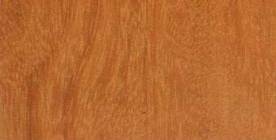 KOPIE
KOPIE

Wood Technical Fact Sheet
Goupia glabra
Kopie
Kabukalli
Family: Goupiaceae (Celastraceae)
Other Common Names: Saino, Sapino (Colombia), Kopi (Surinam), Kabukalli (Guyana), Goupie (French Guiana), Cupiuba (Brazil).
Goupia glabra
Kopie
Kabukalli
Family: Goupiaceae (Celastraceae)
Other Common Names: Saino, Sapino (Colombia), Kopi (Surinam), Kabukalli (Guyana), Goupie (French Guiana), Cupiuba (Brazil).
Distribution: Uplands of the lower Amazon, the Guianas, and the Serrania de San Lucas, Carare-Opon, Rio Cauca Valley, and other regions of Colombia.
The Tree: A large buttressed, semi-deciduous, canopy tree; grows to a height of 130 ft and with diameters to 36 in., but usually 20 to 24 in.
The Wood:
General Characteristics: Heartwood light reddish brown, darkening superficially upon exposure; distinct but not sharply demarcated from thick brownish or pinkish sapwood Luster medium to rather high; texture medium to coarse; grain straight to interlocked; odor is fetid when fresh but dissipates upon drying though still apparent.
Weight: Basic specific gravity (ovendry weight/green volume) 0.72; air-dry density 54 pcf.
Mechanical Properties: (First two sets of data based on 2-in. standard; third set the 2-cm standard.)
Moisture content Bending strength Modulus of elasticity Maximum crushing strength
(%) (Psi) (1,000 Psi) (Psi)
green (73) 11,480 1,810 6,170
12% 15,300 2,150 8,350
12% (24) 16,600 2,370 10,850
green (48) 14,000 1,980 7,350
15% 17,600 --- 9,750
Janka side hardness about 1,400 lb for green material and 1,840 lb at 12% moisture content. Forest Products Laboratory toughness average for green and dry material is 132 in.-lb (5/8-in. specimen).
Janka side hardness about 1,400 lb for green material and 1,840 lb at 12% moisture content. Forest Products Laboratory toughness average for green and dry material is 132 in.-lb (5/8-in. specimen).
Drying and Shrinkage: Moderately difficult to air-season, dries at a moderate rate with only slight warping and checking. Kiln schedule T7-B3 is suggested for 4/4 stock. Shrinkage from green to ovendry: radial 4.5%; tangential 8.0%; volumetric 12.6%.
Working Properties: It is rated fair to good in most operations but torn and chipped grain is common in planing because of interlocked grain. Coarser material requires filler to obtain a smooth finish.
Durability: Laboratory evaluations indicate good resistance to attack by both brown and white-rot fungi, but rated only slightly to moderately resistant to decay in field tests in Guyana. Resistant to dry-wood termite attack but has little resistance to marine borers.
Preservation: Heartwood is very resistant and sapwood is moderately resistant to preservation treatments using either open-tank or pressure-vacuum systems.
Uses: Heavy construction, industrial flooring, furniture components. A highly favored general purpose timber in the Guianas.






